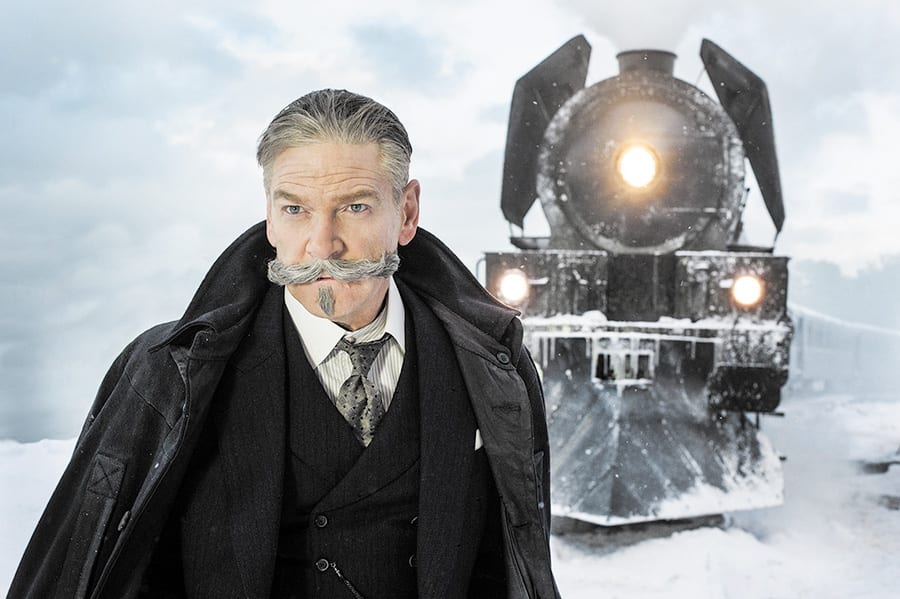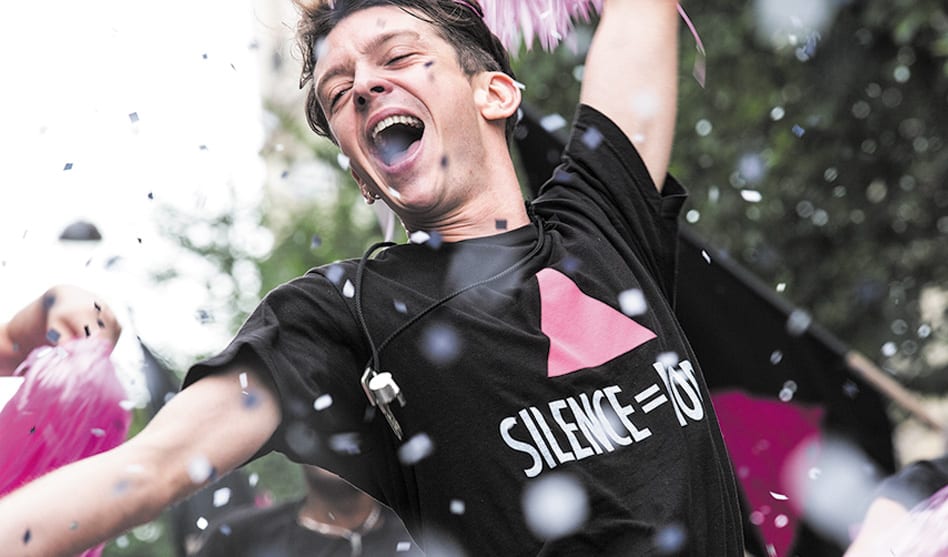ACT UP activist Sean finds reason to celebrate in ‘BPM,’ above; opposite, Hercule Poirot exercises his little grey cells aboard the Orient Express.
French activists fight to live in ‘BPM;’ a Belgian sleuth solves a ‘Murder’
ARNOLD WAYNE JONES | Executive Editor
jones@dallasvoice.com
If you didn’t live through the AIDS crisis of the 1980s and early 1990s — and, sadly, many didn’t — hearing about “the AIDS crisis” can feel like an abstraction. Yes, HIV is still a scourge, and yes, people continue to die of its complications, but treatments have altered the landscape. In 1987, “you have HIV” was a death sentence; in 2017, it’s a diagnosis.
Which is why in New York in 1987, a group of mostly HIV-positive, mostly gay, mostly men formed ACT UP (AIDS Coalition to Unleash Power), an activist organization with the mission, then as now, to unite in anger, to fight complacency, to demonstrate. If you think the Black Lives Matter movement is politically charged, you’d be cowed by ACT UP’s tactics.
The members were not silent, or polite, or even diplomatic. For most of them, there was no time for such half measures.
Infection was a ticking clock, insidious partly because it struck many men in the prime of life when they were otherwise fit and healthy and sexually empowered. But more than a health crisis, or even a threat to life, it was a political and societal earthquake. People still in the closet — and in the 1980s, that was undeniably the vast majority of gay men — were instantaneously outed, stigmatized, branded, rejected. So frightening was the unknown of the disease that those afflicted were pariahs in their families, at work. It was a plague. It was mysterious. And the stakes were unfathomable.
I recount all this context because it is essential for fully appreciating the contradictory authenticity of BPM, a powerful document about our recent history. It’s set not in New York, but in Paris, in the early 1990s, where the French branch of ACT UP was doing there what its counterpart was doing here. The members are outraged that the federal government isn’t acting quickly enough, that big pharma won’t release trial data and is wasting its time on a lark they call protease inhibitors…
Wait. Wasn’t that one of the great innovations in AIDS research?
Which is what makes BPM such an unexpected profile of a period of turmoil. Often in films about activism, the heroes are always right, morally superior and flawlessly omniscient. Every cause they champion is the right cause, every tactic necessary, every perceived villain borne out as evil. (It was one of the weaknesses of Dallas Buyers Club.) But here, the ACT UP folks aren’t always right. They don’t have the time or education or even perspective to be right, at least not all of the time. They are, instead, desperate. They are motivated. They are true believers. So, when they hurl fake blood at pharmaceutical suits, or heckle researchers speaking to their group, you sense their passion is earned but their judgment misplaced.
Or maybe not. Co-writer/director Robin Campillo doesn’t make it easy to like everyone, or to hate everyone. He does something much more difficult — he makes you feel for everyone.
And none more than Sean (Nahuel Perez Biscayart), who’s HIV-positive, and Nathan (Arnaud Valois), who’s negative but gets involved in ACT UP anyway. They become lovers, but the urgency of advances in AIDS treatment means different things to both. Their romance forms the crux of the human element, moving the issues from the abstract to the concrete.
The details of their situations are doled out slowly and realistically; BPM has the studied interpersonal pacing of Blue Is the Warmest Color and the emotional resonance of Longtime Companion. It doesn’t hit you over the head with its indignation.
As a result, while many plot points play out predictably, they don’t feel like cliches so much as inevitable truths.

Agatha Christie was the master of surprise twists and cleverly plotted mysteries, but her Murder on the Orient Express, while devilish (and infamous), isn’t one of the most satisfying of her resolutions. Sidney Lumet’s 1974 version is less remembered for its dull pacing and stagey finale than for being a stylish all-star portmanteau — the kind that all but disappeared with the decline of disaster movies, at least until indie films gave stars wanting to slum it for a low pay and high praise a reason to slum it. Then superhero movies created a whole new market for it.
Now, 40 years later, Christie is back, entrusted to the capable hands of Kenneth Branagh. Branagh is one of those directors who has always attracted top stars for his artsy movies (look up the casts for some of his Shakespeare adaptations) and who has directed a Marvel film (Thor). So it makes sense that Fox would pony up the salaries and marketing for him to trot out a prestige remake at a time when Christie is hardly considered hot and bankable. But let Branagh assemble one of those casts that will naturally attract a host of movie nerds and middle-brow literary fans, and there’s a built-in audience — maybe not one chock full of Millennials, but Gen X-ers and Boomers deserve smart movies with glamor, too.
And then there’s learning from Lumet’s dry run … emphasis on dry. Branagh’s version both prunes and expands the cast, populating the corners with extras and trimming the running time by about 10 minutes while enlivening the pace and upping both the humor level and the emotional honesty (more drama, less melo). The result is a crackling mystery, talky but visually arresting.
Branagh himself plays the pretentious Belgian sleuth Hercule Poirot, who, aboard a snowbound luxury liner in the middle of Switzerland, investigates the murder of a shadowy American (Johnny Depp), repeatedly stabbed in a coach that only 12 passengers had access to. And all of them it seems have some connection to the dead man and wouldn’t mind seeing him rot. When everyone with means and opportunity also has a motive, how do you narrow the suspects?
Christie has always concentrated more on internecine plots than character development, but that’s where Michael Green’s adaptation and Branagh’s inherent flair do much of the heavy lifting. His Poirot is prickly and vain, but also endearingly deft, with a dash of showmanship. When Branagh keeps us on the train, the camera glides its wide lens fluidly across the faces of the suspects; when he goes outside it, as in the sunny prologue, the shots are as gorgeous as an adventure travelogue. He’ll then slip in a sly visual joke (note the placement of the suspects during the Big Reveal) without losing focus. It’s as beautiful as any movie in theaters right now.
But Branagh is equally adept at evincing subtle character work from a cast that includes returning actors (Derek Jacobi, Judi Dench) and welcome newcomers (Daisy Ridley, Leslie Odom Jr.) plus some old hands (Michelle Pfeiffer, Willem Dafoe) relishing the chance to go big yet still hint at mystery beneath. The resolution seems more earned this time, more weighty and more brutal. There’s a suggestion that this may be the first entry in a Branagh/Poirot series. I can’t say that’s a bad idea. In fact, it stimulates my little gray cells.
Both films now playing.
















